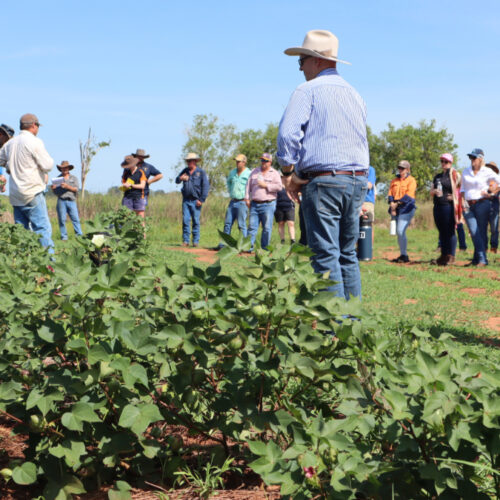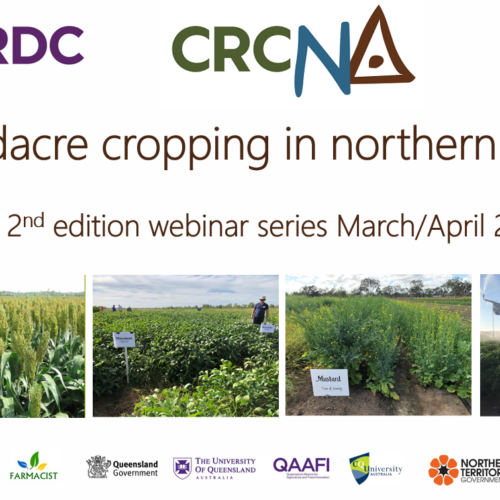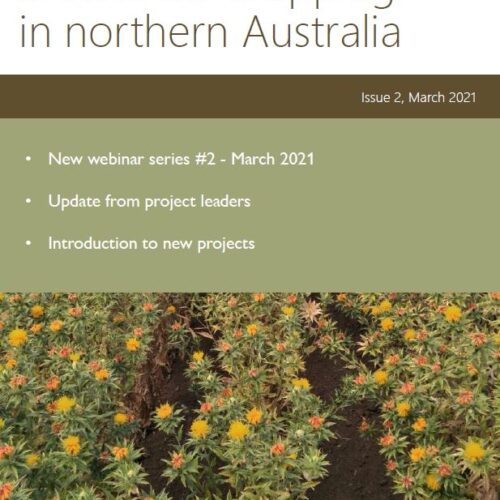
- Reference # A.2.1819004
- Project Status Current
- Timeframe 2 years 5 months (2020 to 2023)
- Project manager Ian Biggs
- CRCNA Funding $665,002
- Total project value $1,885,852
- Project research participant NT Dept. Industry, Tourism and Trade (NT DITT) ; University of Southern Queensland (USQ) ; CSIRO ; NT Farmers Association ; NT Dept. Environment, Parks and Water Security (DEPWS) ; Qld Dept. Agriculture and Fisheries (DAF) ; Tipperary Group of Stations ; Northern Livestock and Agriculture Pty Ltd (Ruby Downs) ; NT Agricultural Company Pty Ltd (Edith Springs Station) ; Horse and Cattle Co (Carbeen Park) ; Oolloo Farms ; Glen Arden Cattle Company ; Cotton Seed Distributors (CSD) ; Cotton Research and Development Corporation (CRDC)
- Research Programs 2. New and developing industries in Northern Australia
- Location Katherine, Darwin, Douglas Daly, Ali Curung, Alice Springs, Roper River, Townsville, Toowoomba, Kingaroy
- Broadacre cropping
- Agriculture
Summary
This project includes co-investment from the Grains Research and Development Corporation (GRDC) and the Cotton Research and Development Corporation (CRDC) with funding reported here as combined CRCNA funding.
It will collate historical broadacre cropping data, natural resource information and an understanding of market opportunities to support the development of viable broadacre cropping systems in the NT. This will be achieved by project participants who each bring unique expertise to develop crop management strategies which will help to de-risk broadacre agriculture in the Top End.
The initial focus of this project will be on dryland and irrigated systems growing cotton and peanut crops, while maize, sorghum, rice and pulse crops will also be investigated as possible ‘break crop’ options for cotton and peanut producers. A mixture of on-field and simulation techniques will be used throughout this project.
On-farm demonstration crop plots planted on commercial properties will serve two purposes:
- Additional testing of the crop simulation models
- Experience for the producer and extension site for promoting agricultural method to local producers.
A component of the extension plan for this project will introduce producers to simple methods to establish precision and robustness for on-farm crop trials. The project will work with collaborating farmers to ensure the on-farm demonstration plots are achieving their goal while not impeding commercial farm operations.
Additionally, researchers will investigate harvesting wet-season flood flows into off-stream storages and undertaking dry-season cropping as a viable irrigation alternative which could support further agricultural development across the Northern Territory.
Researchers will develop a natural resource (soil and climate) database for the NT to further support agronomic decision-making and help identify potential crops, the timing and length of the potential cropping windows, and the impacts of climate and edaphic conditions on yield and quality. These factors ultimately determine the productivity of broadacre cropping systems and thus the potential of diversifying pastoral leases. For those crops which will technically grow based on available resources and environmental conditions, there must also an analysis of their market opportunities to support their successful adoption.
Expected outcomes
A critical output from this project will be an assessment of the regional potential for broadacre cropping in the NT. While it is a long-held belief that this potential exists, this project will build on earlier studies to capture this potential across the Katherine/Douglas Daly region, building on the CSIRO NAWRA study for the Darwin regions. The assessment of the potential for NT broadacre agriculture and the potential expansion of NT broadacre agriculture will guide further RD&E in both this project and in future research.
- Cropping simulation tools will provide an indication of the overall potential for broadacre cropping in the NT. When this is combined with an assessment of market possibilities and basic economic analysis, this project will provide an indication of the potential scope for broadacre cropping in the NT and highlight areas where additional research will assist with achieving the identified potential.The project will highlight the usefulness and limitations of simulation tools as a regional scale assessment tool for the purpose of determining regional agricultural potential and make recommendations for the use of simulation tools and areas for further research.
- A natural resource database will establish files for use in cropping simulations and also develop processes which will enable interrogation of this data by interested parties. This will allow for a greater understanding of the wet season start and end dates, including any variation of the wet season length and rainfall distribution within a wet season. Understanding the length of a crop window aids selection of the appropriate crop for that season and when linked to known markets, allows the farmer to have an understanding of the possible return for a particular crop to match that season’s crop window.
- Provide strategic information to de-risking of crop development on selected sites and guide the further selection of potential sites across the NT and broader northern Australia. The data generated will be made available to pastoralists, landholders, developers and investors to support their due diligence for agricultural proposals and developments.
- Expansion of broadacre cropping across NT. The Northern Territory Farmer’s Association believes if the NT realises its potential, there will be a significant expansion of broadacre crops grown by 2029, generating hundreds of direct jobs ( 300 across the cotton industry alone). These growth figures are :
- Sorghum from 70 ha to 5,400 ha
- Soybean from 0 ha to over 4,000 ha
- Mungbeans from 20 ha to 6,000 ha
- Peanuts from 0 ha to over 6,000 ha
- Cotton from 90 ha to over 35,000 ha
Publications
30 April 2021
Potential for broadacre cropping in the NT – webinar
Type: Webinar
Industry: Broadacre cropping
2 March 2021
Broadacre cropping in Northern Australia newsletter Vol #2
Type: Fact sheet
Industry: Broadacre cropping




